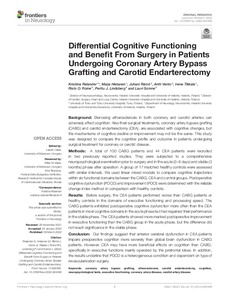Differential Cognitive Functioning and Benefit From Surgery in Patients Undergoing Coronary Artery Bypass Grafting and Carotid Endarterectomy
Relander Kristiina; Hietanen Marja; Rämö Juhani; Vento Antti; Tikkala Irene; Roine Risto O.; Lindsberg Perttu J.; Soinne Lauri
https://urn.fi/URN:NBN:fi-fe2022081154958
Tiivistelmä
Background
Stenosing atherosclerosis in both coronary and carotid arteries can adversely affect cognition. Also their surgical treatments, coronary artery bypass grafting (CABG) and carotid endarterectomy (CEA), are associated with cognitive changes, but the mechanisms of cognitive decline or improvement may not be the same. This study was designed to compare the cognitive profile and outcome in patients undergoing surgical treatment for coronary or carotid disease.
Methods
A total of 100 CABG patients and 44 CEA patients were recruited in two previously reported studies. They were subjected to a comprehensive neuropsychological examination prior to surgery and in the acute (3-8 days) and stable (3 months) phase after operation. A group of 17 matched healthy controls were assessed with similar intervals. We used linear mixed models to compare cognitive trajectories within six functional domains between the CABG, CEA and control groups. Postoperative cognitive dysfunction (POCD) and improvement (POCI) were determined with the reliable change index method in comparison with healthy controls.
Results
Before surgery, the CEA patients performed worse than CABG patients or healthy controls in the domains of executive functioning and processing speed. The CABG patients exhibited postoperative cognitive dysfunction more often than the CEA patients in most cognitive domains in the acute phase but had regained their performance in the stable phase. The CEA patients showed more marked postoperative improvement in executive functioning than the CABG group in the acute phase, but the difference did not reach significance in the stable phase.
Conclusion
Our findings suggest that anterior cerebral dysfunction in CEA patients impairs preoperative cognition more severely than global brain dysfunction in CABG patients. However, CEA may have more beneficial effects on cognition than CABG, specifically in executive functions mainly operated by the prefrontal lobes. In addition, the results underline that POCD is a heterogeneous condition and dependent on type of revascularization surgery.
Kokoelmat
- Rinnakkaistallenteet [27094]
